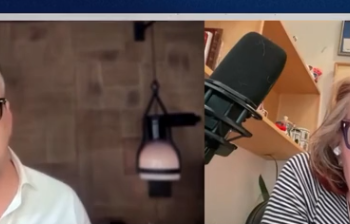
KFAR AZA, ISRAEL — The tranquility of Kibbutz Kfar Aza, a small Israeli community just a mile from the Gaza border, was shattered on Oct. 7, 2023, by a brutal Hamas-led assault that left 67 residents dead, 19 kidnapped and almost every household scarred by violence. The attack was one of the deadliest in the nation’s history and exposed the vulnerability of a community defined by its optimism and hopes for peace.
The scars are still visible at Kibbutz Kfar Aza a year and a half after 250 Hamas terrorists launched a brutal assault against the snug farming community in southern Israel. Buildings remain pockmarked with bullet holes, and nearly every home in an area set aside for young kibbutz residents was destroyed in the fierce fighting.
About 950 people lived in Kfar Aza when the first wave of militants used paragliders to fly over the fence line separating the kibbutz from the Gaza Strip. After explosives were detonated at the main gate, dozens of Hamas pickup trucks and motorcycles poured through the gap.
Two hostages taken from Kibbutz Kfar Aza, twin brothers Ziv and Gali Berman, 27, are still being held somewhere inside the Palestinian enclave, officials believe.
Shachar Shnurman wryly calls himself one of the junior residents of Kfar Aza because he has lived there only 25 years. He was at home on Oct. 7 and alerted to the attack by a series of text messages from kibbutz officials. They said terrorists were shooting people inside the community and warned residents to seek shelter inside their safe rooms.
Mr. Shnurman’s home is at the highest elevation in the geographic center of Kfar Aza. On that day, it was a natural gathering spot for people, including Hamas militants.
“In the first few hours, my wife was asking me when the army was going to come. I told her another half an hour,” he said. “A few hours later, she asked me again, and I told her ‘another half an hour.’”
A neighbor who wasn’t in the kibbutz that day called and asked him to locate his wife. Mr. Shnurman armed himself with a pocketknife, the only weapon he had, and slipped out of his house.
“In the kibbutz, you know everybody, and most of your neighbors are friends,” he recalled. “I found my next-door neighbor after she had been murdered.”
Mr. Shnurman’s wife began crying when he told her.
“I told her, ‘This is no time to cry. Now is the time to fight,’” he said. “We decided that we would fight for our lives if the terrorists tried to get inside our house. But they didn’t get inside.”
The terrorists raced into Kfar Aza from the breach in the fence. The kibbutz’s “young generation” neighborhood was the first the attackers encountered. More than a dozen of the 18- to 35-year-old residents there were killed, and at least seven were kidnapped and taken into Gaza.
Signs placed in front of the bombed and burned-out homes tell the names of some of those killed in the first minutes of the attack. “Ofir Shoshani was brutally murdered inside this house,” one read. “Yuval Buyum was brutally murdered in this house,” read another.
Burned-out shells that once were apartments are pockmarked with bullet holes and scorched by fire. Kibbutz officials said Hamas burned some of the residents alive inside their homes, including many with their hands bound behind their backs.
Other buildings were reduced to rubble by Israeli tank shells in the ensuing battle that lasted for days. Hamas fighters tossed grenades into some of the homes and later barricaded themselves inside during their final, desperate fight against the advancing Israeli forces.
Shahar Schnurman and his wife hid inside their safe room until they heard the arrival of the Israel Defense Forces late that night.
Mr. Schnurman is one of about 30 Kfar Aza residents who have returned to the kibbutz since the fighting stopped. He said the army would prefer that everyone stay out until the government’s war with Hamas comes to an end.
“The government doesn’t support us to come back,” he said. “I decided that I won’t ask the army what to do. Every time someone tells me, I ask where they were on October 7th.”
Some work crews are in the kibbutz trying to repair the damage while Israel Defense Forces troops stand guard against any new Hamas incursion.
Orit Zadikevitch was born and raised at Kibbutz Kfar Aza. She later married and raised a family there. Her grown children weren’t there during the attack, but her husband and brother-in-law were killed. Her 84-year-old mother survived only because she wasn’t discovered by the invading Hamas militants.
“She was all by herself. She couldn’t reach the safe room,” she said.
Ms. Zadikevitch recalled going into Gaza to swim in the warm waters of the Mediterranean when she was growing up. It was a time of hopeful optimism when many Kfar Aza residents dreamed of peaceful relations with their Palestinian neighbors.
After Oct. 7, she said those sentiments were gone.
“We are still at war. We are still fighting. We still want all of our hostages back,” Ms. Zadikevitch said. “It’s going to take a long time before we can build some trust between us.”
About 15 minutes from Kfar Aza is the site of the Supernova Music Festival, where Hamas terrorists killed more than 360 people and took 40 hostages.
Many of the victims were sexually assaulted, and others were found with their genitals mutilated. The carnage was often recorded on GoPro cameras carried by the Hamas fighters.
The Nova Site, as it has become known, has become a makeshift memorial to the young people at the music festival. The main stage remains intact, and photographs of the victims are affixed to posts sunk into the ground. Family and loved ones have left behind flowers and other personal keepsakes.
Yevgeny Postel’s girlfriend left a message at his memorial site: “Yevgeny was a pure-hearted, sensitive and caring person who always put others before himself,” she wrote. “He was always the first to offer help wholeheartedly, a friend who will stand by you no matter what.”
Elad Bouhnik, 16, came to Nova Site with his classmates and said the experience made him sad.
“These people didn’t do something bad; they just died,” Mr. Bouhnik said. “They wanted to dance and enjoy life, and they just got slaughtered. This is what our enemy can do.”







![‘We All Owe Him (Elon) a Huge Debt of Gratitude’ [WATCH]](https://www.right2024.com/wp-content/uploads/2025/03/‘We-All-Owe-Him-Elon-a-Huge-Debt-of-Gratitude-350x250.jpg)

![Trump's Admin Guts Another ‘Rogue Government Agency with Zero Accountability’ [WATCH]](https://www.right2024.com/wp-content/uploads/2025/03/Trumps-Admin-Guts-Another-‘Rogue-Government-Agency-with-Zero-Accountability-350x250.jpg)







